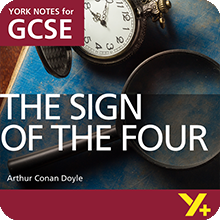Examiner's Notes
You assessed this answer as a Very High.
Hover over the highlighted text to read the examiner’s comments.
- in this extract?
- in the novella as a whole?
Conan Doyle uses direct speech and the description of the boat to create a sense of excitement and suspense in this extract. This section of the text could be seen as the climax to the novella, as the thief has been located but has not been captured by Sherlock Holmes, which also adds to the tension in this extract. The idea of the chase to catch the ‘evil’ villain is an important part of the genre of the detective/adventure novel.
In the opening paragraph of this extract Conan Doyle uses exclamative sentences in the direct speech to reinforce the urgency that the character of Sherlock Holmes feels at this time. The hyperbolic simile ‘going like the devil!’ emphasises the tension as it reiterates the speed at which the Aurora is travelling. Conan Doyle also draws attention to the assertiveness of Sherlock Holmes’s directions through the verbs used: ‘exclaimed’ in the first paragraph and ‘cried’, which is repeated twice in the extract. These verbs illustrate the urgency of Holmes’s instructions, which is also echoed by his use of imperative verbs to command the boat’s crew: ‘Heap it on’ and ‘Make her do all she can!’. In the first and second paragraph these urgent instructions contrast with the attitude of the character Jones, who provides doubt in the reader’s mind through the use of the adverb ‘gravely’ to describe how he looks at the distance between the boats and through expressing his ‘doubt’ that they will catch her.
Conan Doyle also uses description to create a sense of excitement, particularly through the descriptions of the boat. The reference to the boat as ‘she’ personifies the boat. This is echoed by further descriptions of the boat’s engine ‘like a great metallic heart’. Attaching this sense of humanity to the boat creates a sense that the boat is part of the chase and also wishes to catch the villains. It creates tension as it suggests danger as the boat is straining itself to try and catch the villains, as a human would if they were in this chase. At this point, therefore, the reader also considers that the boat may fail to catch up. The verbs ‘sprang and quivered’ are also used to describe the boat, which creates a sense of the boat being alive and moving erratically.
Excitement and suspense is also created in a similar way in other parts of the novel which involve dramatic action and chases, which are an important element of the genre of detective fiction.
The narrative structure ensures that through each of these dramatic events a further clue is revealed that foreshadows the ending, so maintaining the suspense. A good example of this is the mysterious note received by Mary Morstan that leads to the tense cab ride to the home of Thaddeus Sholto in a ‘questionable and forbidding neighborhood’. Conan Doyle often uses descriptions of Victorian London as a threatening and dangerous place to emphasise the sense of danger. This reflects Victorian attitudes to criminality which often implied that crime was associated with poorer areas in the City. Suspense is created here as the reader assumes that the next action in the plot will involve danger, as the writer uses changes in the narrative pace and direction to add to the sense of mystery. This is contradicted when they actually meet Thaddeus Sholto, who is a weak and nervous character. He does however develop the narrative as he reveals to them the story of the treasure and the death of Mary Morstan’s father.
In conclusion, excitement and suspense is an intrinsic part of the novel ‘The Sign of the Four’, as it reflects the narrative structure needed to create a successful detective novel.
